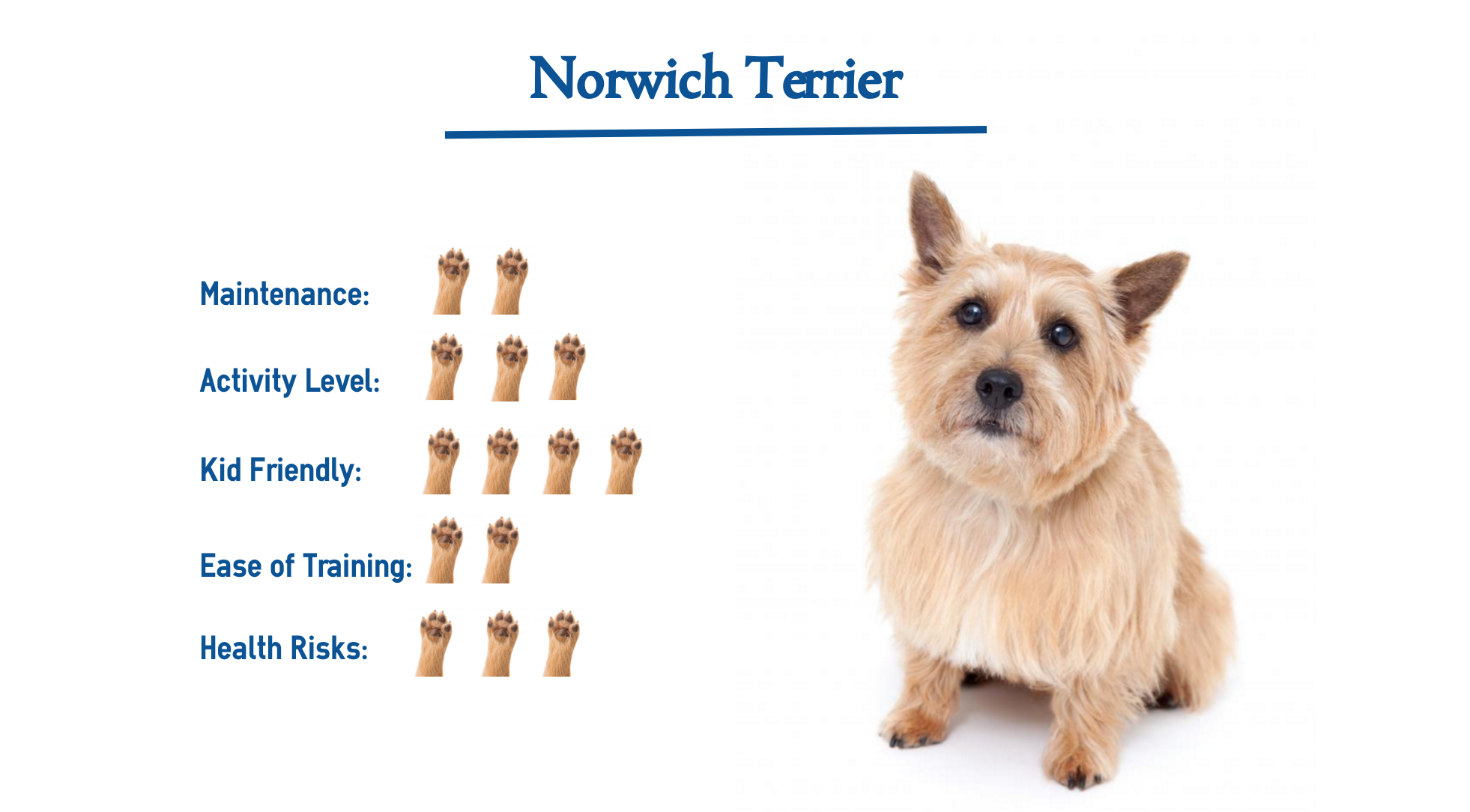Faithful and friendly… that’s the Norwich Terrier Dog. This is one of the reasons why we here at IndulgeYourPet love these little guys. But because we love these little guys doesn’t mean they will automatically be “right” for you.
For this reason…
We wanted to take a moment and talk about the Norwich Terrier dog breed in a bit more detail so that if you’re ever allowed to own one of these awesome little guys, you’ll know for sure whether or not it’s a good idea!
So, without further ado, let’s dive right in.
Norwich Terrier Dog Breed Fast Facts
Country of Origin: England
Original Purpose: Ratting and fox bolting
Height: 10 inches at the shoulder
Weight: 11 to 12 pounds
Dog Breed Classification: Terrier group
Life Span: 12 to 15 years
Origin of the Norwich Terrier
While it’s probably impossible to determine when “exactly” this little Terrier came into existence since he is so closely related to the Norfolk Terrier, what is known is that right around the start of the 19th century, one particular Norfolk Terrier by the name of “Rags” really proved himself to be quite a “matter.”
So much so…
He was used to sire countless litters, and it just happened that “Rags” lived right next to Norwich. And over time, “Rags” offspring began to take on specific characteristics, which is why folks started referring to them as Norwich Terriers rather than Norfolk. Some folks even referred to them as “Jones Terriers” since “Rags” was owned by Mr. Jones.
And while…
The Norwich and Norfolk Terriers were once considered the same breed, called the Trumpington Terriers (nothing to do with President Trump!). The American Kennel Club separated the Trumpington Terrier into two different breeds: Norfolk Terriers, which have drop ears, and Norwich Terriers, which have prick ears.
A breed standard…
For the Norwich Terrier was recognized by the American Kennel Club (AKC) in 1936. The Norwich Terrier Club was started shortly after. The Norwich Terrier remains popular in the United States and the UK.
Physical Characteristics
The Norwich Terrier is a small breed. The adult dog is only 10 inches at the shoulder level and weighs only 10 to 12 pounds. The Norwich has short legs, a wiry coat, and pointed prick ears. He has a muscular, stocky body structure, a round skull, a well-defined stop, and a slender muzzle. He has dark, expressive, almond-shaped eyes covered by black rims. He also has a double coat that is thick inside and wiry on the outside. His double coat is grizzle, red, wheaten, black, and tan.
Temperament and Personality
The Norwich Terrier is among the best family dogs, especially if you have children at home. He is a playful, active, energetic dog and loves kids. He enjoys being a part of their games and always stays energized. Plus, Norwich Puppies, in particular, are adorable. A Norwich puppy that grows up with your kids treats them as his siblings and forms an extraordinary bond with his owners, one that lasts the rest of his life.
But be warned…
These little guys can be fierce when he wants to be – he makes for an excellent watchdog, and you can trust him to watch your kids as they play outside the house. He will warn you if he suspects anything amiss, such as a potential intruder approaching your property. But remember, these guys are “Terriers,” and like most terriers, he loves digging. And if there is one thing that the Norwich Terrier likes, it’s searching. He can dig and explore for hours. He can be relentless at that.
He can dig…
Beneath the fence when you’re not looking. He has a strong prey drive and always digs because he constantly searches for prey.
Trainability
The adult Norwich is intelligent, eager to please, and enthusiastic about learning new tricks. He is responsive to his owners’ commands and does well at most dog sports. However, Norwich puppies are not so easy to train. They resist training – albeit cheerfully. Crate training them is not easy. But they can come around, provided you are persistent and use positive reinforcement training methods.
Potential Health Problems
The Norwich Terrier is relatively healthy. He has a life expectancy of 12 to 15 years but can live longer, provided he gets the right medical attention on time if he falls sick. He is known to suffer from the following health problems…
- Collapsing Trachea,
- Epilepsy,
- Mitral Valve Disease,
- Glaucoma,
- Lens Luxation.
And while many of these conditions may not be life-threatening, they can become quite expensive, particularly if they become recurring issues. This is why we here at IndulgeYourPet also recommend that any new pet owner take a moment and see what it might cost for you to purchase a pet insurance policy for your new animal.
Now will a pet insurance policy be suitable for everyone?
No, probably not. But until you fully understand what these policies “will” and “won’t” cover and how much these pet insurance policies cost, how will you know if one might be right for you?
For more information on who we feel currently offers the “best” pet insurance policies out there, we would encourage you to check out our Best Pet Insurance Policies article.



